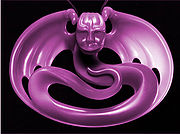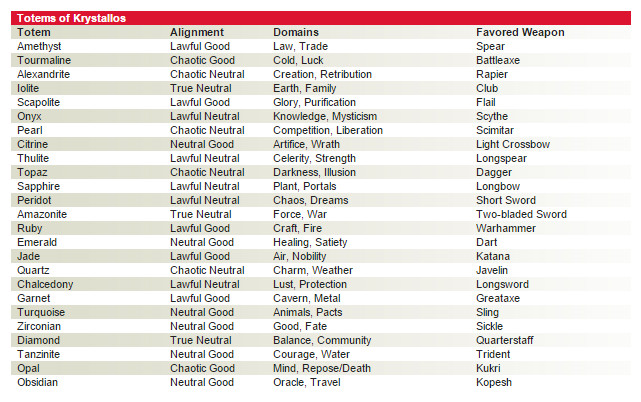Religion
Contents
The Totems of Krystallos
While the Totems all belong to the same pantheon there is a fairly wide range of religious practices throughout Krystallos. Since the Totems exist as physical forms they aren’t generally imagined as having organic forms. The Totems aren’t seen as personalities but, rather, elemental forces that influence the world. They do choose and empower members of their clergy as Clerics, Healers and Paladins and they have been known to answer the prayers of their followers. A Totem is always the primary deity within their own territory – Amethyst in the Kingdom of Amethyst, Sapphire in the Sapphire Forest, and so forth. However, the other Totems are usually venerated within their spheres of influence. All sailors, for instance, offer prayers to Tanzinite for safe passage on the seas no matter where they are from. The main temple of each Totem is centered around the Totem itself. However, there are multiple smaller temples throughout the lands – each containing a small gem shard chipped from the Totem that serves as a link. Clerics and the faithful often have small shards of the Totems as well.Organization
The organization of each Totem's worshipers varies from faith to faith. The worshipers of some Totems, such as Scapolite, are very organized and have a complex hierarchy of clerics and temples. Other Totems, such as Peridot, have no true organizational structure and each temple is a separate entity. What remains true across all faiths is that the temple which houses a Totem is known as the Grand Temple among the faithful and the head cleric of the Grand Temple claims the title of Grand Cleric. It is also universal that any cleric may enter a Grand Temple, approach a Totem, and pray for a Shard. If the Totem decides to honor this prayer, a gemstone Shard breaks off from the Totem. The cleric may then take the Shard and found a temple of her own. If a faith is well-organized, the Grand Temple usually works the new temple into their hierarchy.
Icons and Cults
Totems do not interact with their followers in any traditional sense. They do not appear to their followers as avatars nor do they speak to their followers. When Totems do communicate with a follower it is in the form of an epiphany. The follower receives divine inspiration, suddenly knowing something new. This can make it difficult for worshipers to know the will of their Totems. To fill this gap, Totems sometimes elevate particularly inspired or ardent worshipers to a higher status upon death, transforming them into Icons. Icons serve as intermediaries, giving words to a Totem's desires and needs, comfort to their worshipers and, at times, punishment to the unfaithful. Icons are powerful beings who rarely manifest on this plane of existence. They often appear as spirits or in dreams rather than as physical entities.
Because Icons are easier to relate to than the Totems themselves, it is common for worshipers to pray to an Icon, asking him or her to speak to the Totem on the supplicant's behalf. Some groups of worshipers will pattern themselves after an Icon, forming a Cult - a religious organization with specific goals, tenants of faith and vows of behavior. Some Cults are welcomed by the parent faith (assuming there is one) as a valued member of the whole. Others are considered heretical and shunned. Yet, even the mother faith cannot keep Cult leaders from approaching the Totem and praying for a Shard with which to start a temple.
Known Icons include:
- The Green Lady: An Illithid and Cleric of Opal who had light green skin. She popularized the belief that Clerics of Opal should tend to the spiritual needs of the living as well as the dead.
- John the Barber: A Cleric of Emerald who studied anatomy as a way of enhancing divine healing powers.
- Gijima the Sacred Courier: A Cleric of Obsidian and founder of the Order of the Sacred Courier, a world-wide delivery service that ushered in an age of communication and exchange between the peoples of Krystallos.
- Rahoru the Bright-shining: The first Pharaoh of the Citrine Kingdom and, therefore, an Icon of Citrine. Tradition held that his soul would return time after time to possess a new body. Thus, each new Pharaoh of the Citrine Kingdom was also named Rahoru. While Rahoru's status as an Icon is undisputed, few outside of the Citrine Wastes believe the Pharaohs that followed Rahoru were actually the Icon given flesh.
- Ausar the Green-skinned: A Cleric of Opal who developed the funeral rites and mummification techniques used by the ancient Citrines.
- Dina, Lady of Butterflies: A Cleric of Diamond. So moved was she by the plight of refugees fleeing the Great Invasion that she went to her Totem and kneeled in supplication for nine days, begging that they be given a home. So still was she, butterflies by the hundreds came to perch on her. By the tenth day, Dina was so covered in butterflies that she could not be seen. Her prayers were answered and the simple Grand Temple of Diamond became the center of a new Diamond City, a place for the refugees to live.
Personal Totems
In general, people venerate the Totem of their homeland first and foremost. This is simply good sense. You don't go to someone's house and start loudly praising the house of a man down the street. However, most people recognize that different Totems govern different aspects of life. It is customary, when praying on a specific request, to first give praise and thanks to one's home Totem and then to petition the Totem that governs the request (or an Icon of said Totem).
Druids
The Totems radiate power along ley lines that travel the world. These ley lines sustain Krystallos and, without them, the land would wither and die. Originating among the elves but quickly spreading beyond them, Druids are the caretakers of the ley lines. They have raised stone monuments at specific points along ley lines across Krystallos to help maintain the Totem's flow of world sustaining energy using mystical rituals. In return for this task, the Druids have learned to draw power from the ley lines to perform magical deeds. Because Druids serve the ley lines and not any individual Totems, they are not considered clergy.
The Afterlife in Krystallos
Different peoples have different notions of the afterlife. The kobolds, halflings and most human nations believe in the twin lands of Elysium and Gehenna and that souls go to one or the other upon death depending on the quality of one’s life. Exactly what constitutes good deeds and bad might change from culture to culture. The dwarves believe that one’s soul is absorbed by the totem and held in trust until the time comes to be reborn in this world – into either a higher or lower caste depending on one’s life. The elves have a complex afterlife where one is judged moment by moment in a personal ledger and sent to any one of a dozen places of punishment or reward. The gnomes believe there is no afterlife and, so, life must be lived fully in the here and now.
Pantheon of Evil
Before the Great Invasion, Krystallos had no evil deities. The invasion changed all that. The invaders served Tiamat, a goddess of evil. Overseeing the invasion forces were Tiamat’s six god-generals. Each of these beings served as both leaders in the invasion and deities worshipped by the invaders. Since the end of the Great Invasion, Tiamat and her god-generals have been worshipped by pockets of invaders who were left behind when the bulk of the invasion force retreated. They have also become objects of worship by native cults seeking more evil and, some whisper, more powerful entities.
Tiamat: The evil force behind the Great Invasion, no one on Krystallos has seen her and lived. Whispers, however, describe her either as a human with pale skin, dark hair and terrible beauty or as a something disturbingly similar in shape to the Totems of Krystallos, only with five heads.
Vecna: Vecna and his wizard-priests formed the magical muscle of the Great Invasion. A corpse-like being missing his left hand and eye, Vecna wielded magic so powerful he could transform entire battalions to stone or melt them into gibbering pools of slime. Tomes stolen from Vecna’s wizard-priests formed the foundation of wizardry in Krystallos.
Eclavdra: The keeper of Tiamat’s secrets was Eclavdra. She and her legion of spies and seers provided intelligence on Krystallos for the invaders. As sadistic as she is beautiful, she could break the powerful with the merest whisper of a torture. She appears as an elf, though with jet black skin.
Acererak: An army is only as powerful as its weapons and keeps. The same was true of the Invasion. The architect who led Tiamat’s engineers has a knowledge of architecture and craftsmanship that could be much admired if it wasn’t for the perverse deadliness of his creations. Decades were spent destroying Acererak’s fortresses in Krystallos – a task made even more difficult because of the evil that radiated from the very stone of the buildings and the sadistic traps that seemed designed to destroy spirit as much as body.
Strahd: A being of pure evil and the night, Strahd created and led the undead shock troops of Tiamat’s invasion. A thing of nightmares, the pale skinned creature dressed in the clothing of nobles inspired fear as his forces turned night in Krystallos from a time of rest to a time of terror.
Sakatha: A lizardman similar to the kobolds, Sakatha ruled the slaves of Tiamat’s army. The poor wretches who dug trenches for the armies of Venger, cleaned the torture chambers of Eclavdra, served as beasts of burden for Acererak’s engineers, fed the shock toops of Strahd and served as experimental fodder for the wizard-priests of Vecna were under Sakatha’s domain. He is said to have especially relished the chance to break the spirits and warp the bodies and minds of captured Krystallos natives.
Venger: The leader of the troops, Venger was a brilliant strategist whose clever plans destroyed the Kingdom of Obsidian and nearly conquered Krystallos itself. A master of disguise as well as tactics, Venger was known for infiltrating an enemy camp and dining with the general of an opposing force the night before he crushed them in battle.
| Pathfinder: Krystallos | ||
| Setting • People • Locations • Monsters • Journal • House Rules • Noteboard |


